If the Honey Island Swamp Monster leads a hidden tribe, it could blend myth with real survival techniques in the swamp's rich ecosystem. This tribe might embody traits from the creature, using ancient hunting practices that respect nature. They'd likely have deep ties to the land, fostering rituals that honor the spirits of the animals they rely on. As sightings and folklore intertwine, this hidden community could represent the untold stories of survival against environmental challenges. Exploring this idea opens up fascinating layers of cultural heritage and ecological wisdom that could reshape your understanding of the swamp's mysteries.
Key Takeaways
- The Honey Island Swamp Monster may symbolize a hidden tribe's survival, adapting to swamp life through traditional hunting and gathering methods.
- This tribe could possess unique physical traits, resembling descriptions of the monster and reflecting a deep connection to their environment.
- Rituals and spiritual practices within the tribe may honor the land and wildlife, promoting sustainable hunting practices that align with ecological balance.
- The presence of the creature could reinforce community identity and folklore, strengthening cultural ties and storytelling traditions among local populations.
- Conservation of the swamp is crucial for supporting both biodiversity and the potential existence of this hidden tribe, ensuring their survival and cultural heritage.
Origins of the Honey Island Swamp Monster
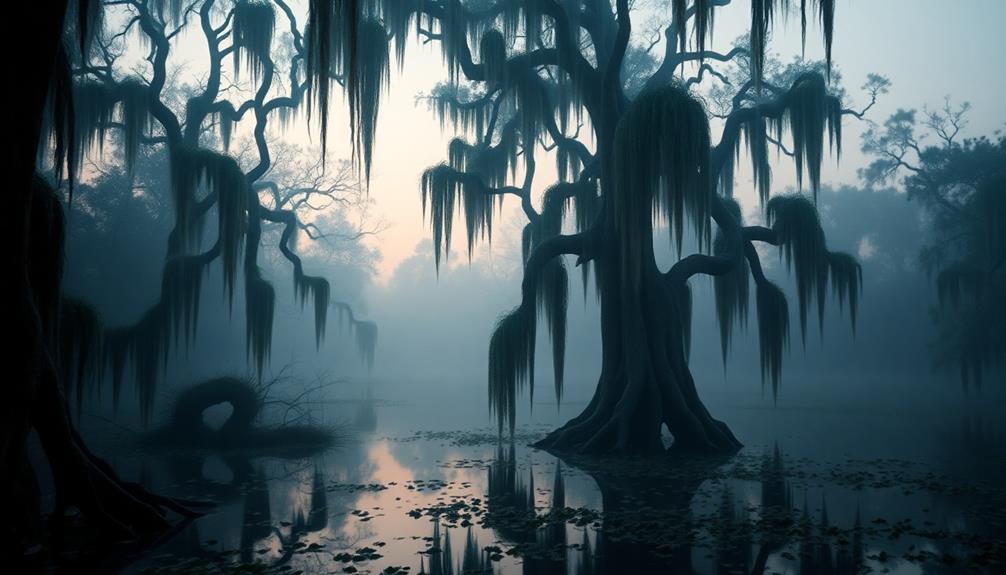
The Honey Island Swamp Monster, shrouded in mystery, has roots that trace back to local Indigenous folklore. Native Americans referred to this enigmatic being as Letiche, a creature believed to be an abandoned child raised by alligators. This legend weaves a poignant tale of survival and adaptation, hinting at a deeper connection between humanity and nature.
The first documented sighting of the Honey Island Swamp Monster occurred in the early 1960s when air traffic controllers Harlan Ford and Billy Mills spotted the creature while hunting near the Pearl River. Eyewitness accounts describe it as a towering figure, approximately 7 feet tall and weighing around 400 pounds, with grayish-brown hair and striking amber-colored eyes.
Over time, various theories emerged about its origins, speculating that it could be a remnant of prehistoric reptiles or even the result of escaped circus chimpanzees from that same era.
This blend of folklore and reported sightings has helped solidify the Honey Island Swamp Monster's place in the region's history, creating a fascinating narrative that continues to intrigue both locals and visitors alike.
Legendary Sightings and Encounters
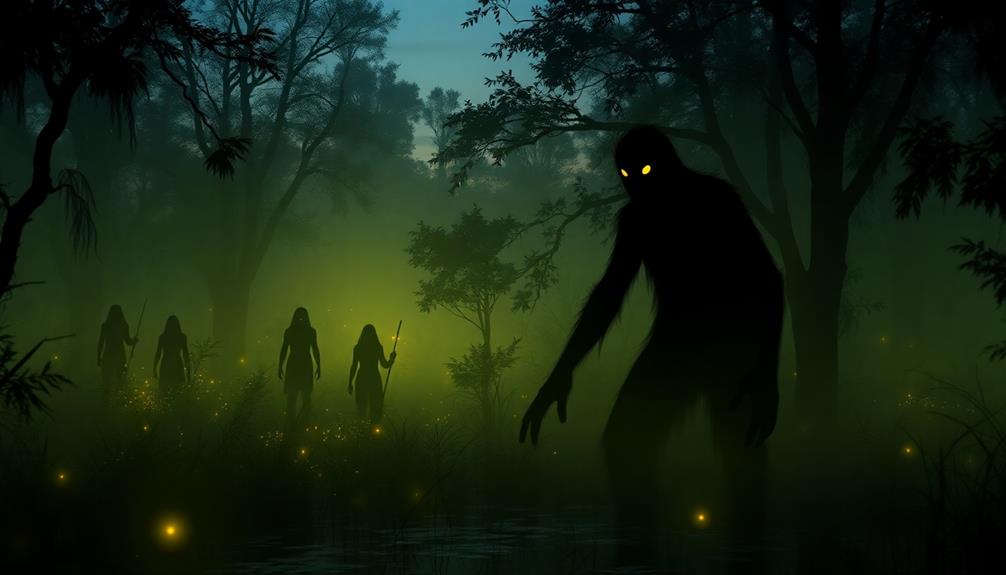
Numerous sightings of the Honey Island Swamp Monster have captivated locals and visitors for decades, each encounter adding to its mythical status. The first documented sighting in August 1963 by air traffic controllers Harlan Ford and Billy Mills described a towering, seven-foot creature with grayish-brown hair and a strong odor.
In 1974, Ford and Mills reignited public interest when they found unusual tracks and a wild boar carcass in the swamp. Witnesses often describe the creature's amber-colored eyes and estimate its weight at around 400 pounds. Local legends refer to it as Letiche or Loup Carou, and its footprints differ from typical Bigfoot tracks, featuring a unique arrangement of toes.
| Year | Notable Encounter |
|---|---|
| 1963 | First documented sighting |
| 1974 | Discovery of wild boar carcass |
| Ongoing | Continuous reports of sightings |
The Honey Island Swamp Monster legend thrives on these encounters, often intertwined with tales of hidden tribes or elusive communities lurking within the swamp. Each sighting keeps the mystery alive, drawing adventurers enthusiastic to uncover the truth.
Folklore and Cultural Significance
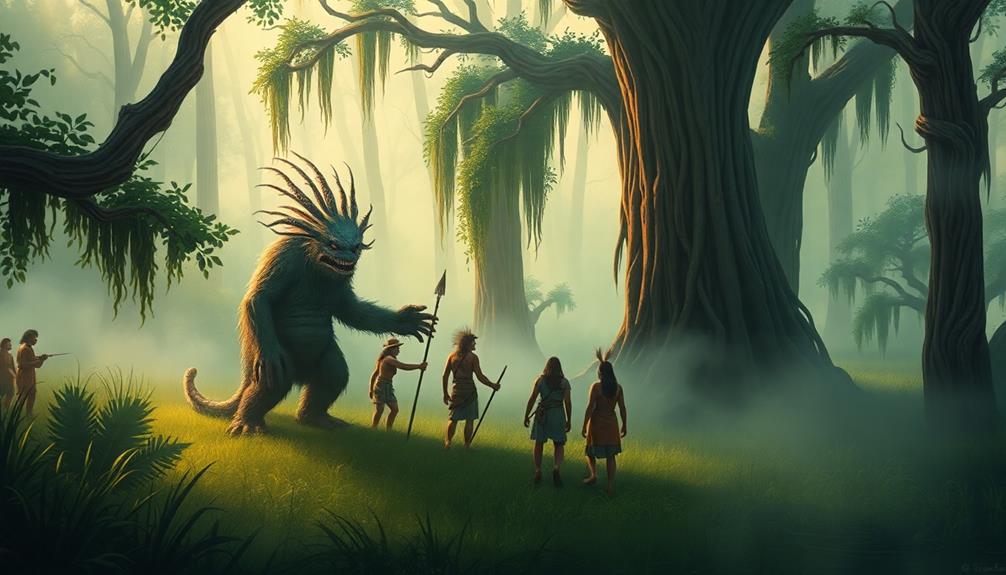
Deep within the lore of Honey Island Swamp, the Honey Island Swamp Monster, or Letiche, emerges as a powerful symbol of cultural heritage. This creature, believed to be an abandoned child raised by alligators, illustrates deep ties to Indigenous beliefs about the swamp.
You'll find that Letiche isn't just a local legend; it embodies the rich tapestry of folklore that defines the region. Cajun traditions also weave in werewolf legends, showcasing how different cultural narratives blend together.
Historical accounts of the swamp monster date back hundreds of years, with stories passed down through generations. These tales hold immense cultural significance, reflecting the values and fears of local communities.
The swamp's mystery has inspired storytelling sessions that strengthen community bonds and preserve unique heritage. As you explore the significance of Letiche, you'll uncover how this creature has become a symbol of local folklore, drawing in tourists and adventurers alike.
The Honey Island Swamp Monster isn't merely a cryptid; it represents the collective imagination and cultural identity of those who call this enchanting swamp home.
Theoretical Hidden Tribe Dynamics
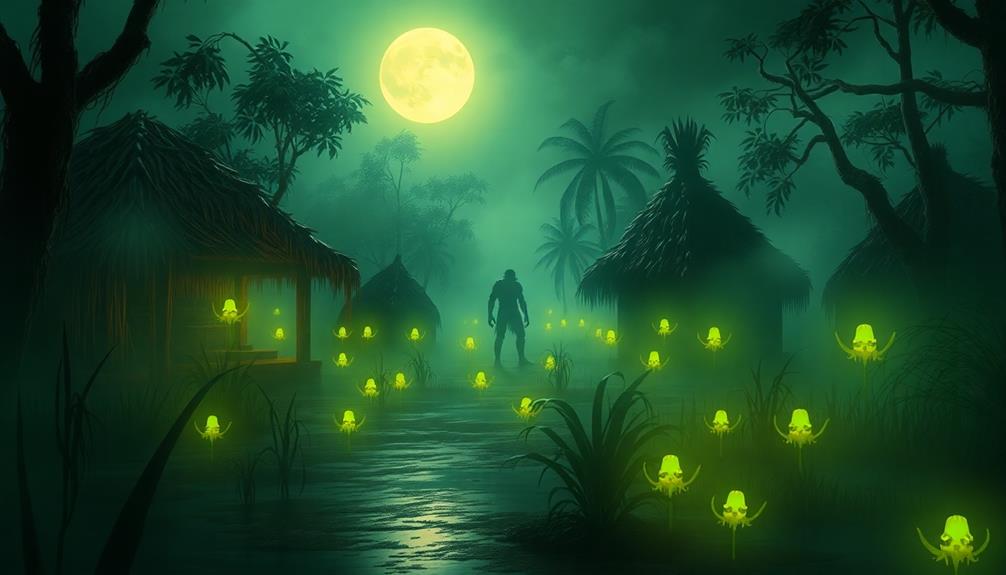
Hidden within the dense foliage and murky waters of Honey Island Swamp, the notion of a secretive tribe raises intriguing possibilities about the dynamics of survival and adaptation in this unique ecosystem.
If a hidden tribe exists, their social structure might be shaped by the legend of Letiche, the abandoned child raised by alligators. This narrative hints at a communal approach to survival, where the tribe nurtures and protects its members, much like the alligators that purportedly raised Letiche.
You can imagine that this tribe would develop physical traits suited for swamp life, perhaps resembling the towering, anthropomorphic descriptions of the Honey Island Swamp Monster.
Their existence could rely on traditional hunting and gathering methods, passed down through generations, allowing them to exploit the swamp's diverse wildlife effectively.
The potential for interbreeding between this hidden tribe and local fauna could create unique societal roles, affecting both physical attributes and cultural practices.
In this way, the dynamics of a hidden tribe wouldn't only focus on survival but also on the intricate relationships formed with their environment, creating a fascinating tapestry of life in the swamp.
Ecological Insights of the Swamp
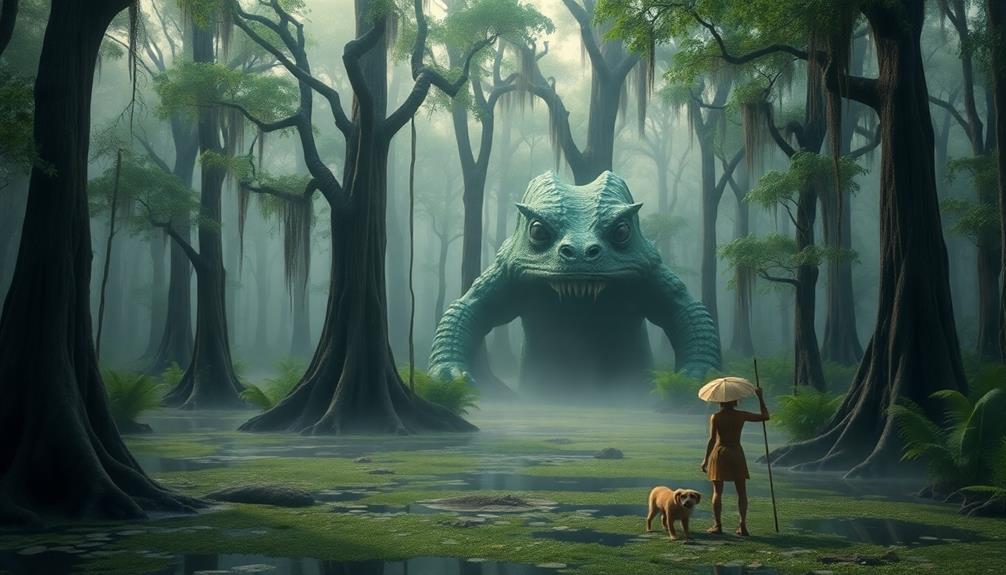
The rich biodiversity of Honey Island Swamp captivates anyone who explores its winding waterways and lush vegetation. This diverse ecosystem supports alligators, deer, black bears, and countless bird species, making it a prime habitat for a potential hidden tribe.
The swamp's unique plant life and aquatic species enhance its ecological diversity, creating a sustainable environment that could easily support a concealed community. Rare and endangered species thrive here, indicating a highly specialized ecosystem essential for survival. A hidden tribe could rely on local resources like fish and edible plants, emphasizing the swamp's richness.
The presence of a bald eagle's nest further underscores the area's ecological significance, as it highlights the need for a habitat that supports critical species.
Moreover, Honey Island Swamp's complex waterways and dense vegetation provide numerous opportunities for concealment, allowing a hidden tribe to thrive away from modern society. This intricate environment not only fosters wildlife but also presents an ideal setting for a community that values ecological harmony and resourcefulness.
Hunting Practices and Rituals

When you explore the hunting practices of the Indigenous tribes in the Honey Island Swamp, you'll notice a deep connection between their traditional methods and the spiritual significance they attach to each hunt.
These communities relied on their intimate knowledge of the land to track wildlife, while rituals like ceremonial dances honored the spirits of the animals taken.
Understanding these practices reveals not just survival skills, but a profound respect for nature that shapes their cultural identity.
Traditional Hunting Methods
In the heart of the Honey Island Swamp, traditional hunting methods reflect a profound connection between Indigenous tribes and their environment. These practices showcase their deep understanding of the local wildlife and its behaviors.
To appreciate their approach, consider the following aspects:
- Traps, nets, and spears: Essential tools that demonstrate skill and knowledge of the swamp.
- Rites of passage: Challenges for young hunters to master tracking, stealth, and survival.
- Sustainable hunting: Taking only what's necessary to maintain the swamp's biodiversity.
- Storytelling: Crucial for passing down techniques and cultural values, reinforcing community bonds.
- Rituals: Offerings to spirits or ancestors, highlighting the respect for nature.
These traditional hunting methods aren't just about survival; they embody a holistic view of living in harmony with the swamp.
Each hunt serves as a moment to connect with the land and its creatures, ensuring that future generations are equipped to honor this delicate balance.
Spiritual Significance of Hunting
Hunting in the Honey Island Swamp goes beyond mere survival; it's steeped in spiritual significance that deepens the bond between humans and nature. Traditional hunting practices among Native American tribes involve rituals that honor the animals, reflecting a profound spiritual connection to the ecosystem. You might find that successful hunts are seen as a partnership with the spirits of the animals. This belief often leads to practices such as offering prayers, songs, or even portions of the kill to appease these spirits.
For many tribes, hunting rites of passage hold great importance. Young hunters learn about responsibility, respect, and gratitude, essential values that guide their connection to the land. During communal gatherings, stories and teachings about local wildlife and the environment are shared, reinforcing cultural identity and community bonds.
Moreover, some tribes practice seasonal hunting that aligns with natural cycles, highlighting sustainability and ecological balance. This approach not only respects the spirits of the animals but also demonstrates a commitment to preserving the environment for future generations.
Embracing these rituals, you'll find that hunting becomes more than a practice; it transforms into a sacred act that honors the intricate relationship between humanity and nature.
Environmental Challenges and Conservation

You mightn't realize that Honey Island Swamp faces serious environmental challenges, like pollution and habitat loss, which threaten its unique biodiversity.
Protecting this delicate ecosystem is vital for maintaining the balance of life in the swamp and supporting any hidden communities that may exist there.
Habitat Protection Efforts
Habitat protection efforts in the Honey Island Swamp are fundamental for maintaining the area's rich biodiversity, which includes numerous rare and endangered species. To guarantee the swamp thrives, it's essential to address several important factors:
- Combat water pollution that threatens aquatic life
- Restore degraded habitats to support wildlife
- Implement sustainable tourism practices to minimize human impact
- Collaborate with local organizations and wildlife agencies
- Raise public awareness about habitat conservation
These conservation efforts focus on preserving the natural landscape and maintaining the delicate balance of both aquatic and terrestrial species.
Local organizations and wildlife agencies actively monitor the swamp's health, implementing restoration projects to counteract the effects of pollution and human encroachment.
Public awareness campaigns play a significant role in educating visitors about the importance of protecting the swamp's habitat. By fostering a sense of stewardship among tourists and locals alike, these initiatives help guarantee that the rich folklore surrounding the Honey Island Swamp Monster remains tied to a healthy ecosystem.
Engaging the community is essential for the success of habitat protection efforts, securing a future where both wildlife and tales of the swamp can coexist harmoniously.
Biodiversity and Ecosystem Balance
The rich biodiversity of the Honey Island Swamp plays an indispensable role in maintaining its ecosystem balance. You'll find various wildlife species here, including alligators, deer, black bears, and wild boar. Each of these animals contributes to the ecological stability by fulfilling specific roles within the food web. The unique plant life also supports this balance, providing food and shelter for numerous species.
Moreover, the swamp is a habitat for rare and endangered species, underscoring the significance of conservation efforts. Protecting this biodiversity is essential not only for the species themselves but also for the overall health of the ecosystem. Environmental challenges like habitat degradation and water pollution threaten this delicate balance, making ongoing conservation efforts necessary.
Additionally, the interbreeding limitations and unique evolutionary adaptations observed in species such as alligators highlight the need to preserve the swamp's natural habitats. By focusing on maintaining this biodiversity, you help guarantee the resilience of the ecosystem against environmental stressors.
Ultimately, safeguarding the Honey Island Swamp is crucial for sustaining its intricate web of life, ensuring that all species can thrive harmoniously.
Impact of Pollution
Pollution greatly threatens the delicate ecosystem of Honey Island Swamp. The impact is profound, affecting both wildlife and potential hidden tribes.
You might be surprised to learn that:
- Sewage is dumped into waterways roughly 600 times daily in the UK, impacting similar areas in the US.
- Rare and endangered species face declining populations due to contaminants disrupting their reproduction and feeding.
- Increased pollution jeopardizes the quality of habitats that could harbor undiscovered species.
- Interbreeding limitations arise among species, threatening genetic diversity vital for survival.
- Sustainable practices and protective measures are fundamental for preserving the swamp's natural beauty.
With pollution on the rise, conservation efforts are more important than ever. The unique biodiversity of Honey Island Swamp is already at risk, and if we don't act, we could lose not just the wildlife but also the potential for discovering hidden tribes that might call this swamp home.
Taking steps to reduce pollution and promote conservation will help guarantee that this precious ecosystem remains intact for generations to come. Your awareness and actions can make a difference in the fight against pollution and for the conservation of Honey Island Swamp.
The Intersection of Myth and Reality

Nestled within the murky depths of Honey Island Swamp, the legend of the Honey Island Swamp Monster serves as a striking example of how myth and reality intertwine. Known as Letiche in local Indigenous folklore, this creature's origins point to an abandoned child transformed by the swamp, hinting at connections to hidden tribal histories.
Historical accounts from tribes like the Chocar and Hummer reinforce this belief, showing that local legends may arise from ancient customs related to the swamp's mystical inhabitants.
Cajun folklore further enriches this narrative, as it intertwines the Honey Island Swamp Monster with werewolf legends. Eyewitness accounts and ongoing sightings blur the lines between myth and reality, suggesting that the creature mightn't just be a figment of imagination but could reflect a hidden community or tribe residing deep within the swamp.
The discovery of unique footprints—some three-toed and others four-toed—raises further questions about the existence of a hidden tribe or species that could have influenced the development of the Honey Island Swamp Monster legend. In this way, the stories you hear may hold more truth than mere folklore suggests.
Conclusion
In the enchanting echoes of the Honey Island Swamp, the possibility of a hidden tribe led by the elusive swamp monster sparks curiosity. This fascinating creature, cloaked in folklore, invites you to explore the delicate dance between myth and reality. As you venture through the vibrant vegetation, remember that every whispered tale and shadowy sighting enriches our understanding of this extraordinary ecosystem. So, keep your eyes peeled and your imagination open—adventure awaits in the wild wonders of the swamp!










